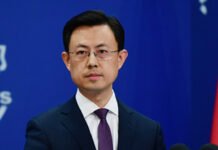– Dave Makkar –
As the world races toward AI dominance, quantum breakthroughs, and digital sovereignty, America’s latest immigration shockwave may be its most self-defeating yet. On September 21, 2025, President Donald Trump signed a proclamation imposing a $100,000 surcharge on new H-1B visa petitions—a move that has already disrupted global talent flows, rattled tech boardrooms, and strained U.S.-India ties.
The executive order, titled “Restriction on Entry of Certain Nonimmigrant Workers”, is framed as a wage correction targeting outsourcing firms accused of underpaying foreign workers. But its impact is far broader. From Silicon Valley to Hyderabad, the tremors are real: startups are freezing hiring, Big Tech is rerouting talent pipelines, and Indian Americans are grappling with diplomatic silence from New Delhi.
Legal experts warn the policy may not survive judicial scrutiny. Immigration scholars, including Prof. Stephen Yale-Loehr of Cornell, argue that imposing such a fee without Congressional approval violates the Administrative Procedure Act. Civil rights groups are preparing lawsuits. But even if overturned, the damage is done. The H-1B ecosystem—once a symbol of U.S. openness and innovation—is now a battleground of wage politics, nationalism, and strategic recalibration.
Wage Gap Realities: Trump’s Logic
In his televised remarks, Trump declared:
> “For too long, foreign outsourcing companies have gamed the H-1B system—bringing in cheap labor, depressing wages, and displacing hardworking Americans. That ends today.”
His critique is backed by data. According to the 2025 H-1B Visa Report by MyVisaJobs, U.S. Big Tech firms offer six-figure-plus packages to global talent, while Indian outsourcing firms cluster around $90,000–$105,000—often below U.S. medians.
For instance:
– Google: $178,184
– Meta Platforms: $199,944
– Microsoft: $163,672
– Amazon Services: $149,812
– TCS: $105,529
– Infosys: $103,102
– Wipro: $93,146
– Tech Mahindra: $103,525
Indian firms often file for lower wage tiers (Level I/II), which pay 20–30% below local medians. The Economic Policy Institute notes that these firms file over 70% of H-1B petitions, contributing to 10–15% wage suppression in IT over the past decade. Trump’s diagnosis of wage distortion is not unfounded—but his remedy is proving economically hazardous.
Fallout: Innovation Interrupted
The tremors of Trump’s H-1B policy are still making waves. As of September 30, 2025, the policy has triggered:
– A 22% drop in new H-1B filings (USCIS preliminary data)
– A 14% increase in Canadian tech visa applications (IRCC)
– A $6 billion projected loss in U.S. startup investment (Crunchbase)
– A diplomatic chill in U.S.-India relations, with India’s MEA calling the move “regressive and discriminatory” in a press briefing on September 29
This was in response to the White House’s defense of the policy, which stated on September 21:
> “A necessary correction to protect American wages and restore fairness.”
But bipartisan voices in Congress are pushing back. Senator Mark Warner (D-VA) tweeted:
> “We need smart reform, not self-inflicted wounds. Innovation doesn’t wear a passport—it builds our future.”
Indian Americans, many of whom are directly affected, were expecting a strong diplomatic intervention from Prime Minister Narendra Modi. Instead, they were stunned by his silence. While PM Modi did mention GST rate cuts and even found time to comment on cricket during a public address, he made no reference to the H-1B crisis. For many, this silence felt like a missed opportunity to stand up for a community that has long been a bridge between the two nations.
Global Talent Rebalancing
India’s tech sector, projected to drive 8% GDP growth in 2026 (NASSCOM), is already absorbing displaced talent. EU hubs, Canada’s Global Talent Stream, and Hyderabad’s AI corridor are seeing surges in applications. Meanwhile, U.S. firms are recalibrating hiring strategies, with some shifting operations abroad.
Brookings Institution research shows H-1B workers “complement U.S. workers, fill STEM gaps, and expand job opportunities,” creating five U.S. jobs per visa. The National Foundation for American Policy warns that restricting inflows could cost 1–2 million U.S. jobs by 2030.
The USCIS 2025 Employer Data Hub, released on September 15, shows H-1B demand up 15% year-over-year, driven by AI, biotech, and green energy sectors. A BBC analysis estimates a $50 billion productivity hit in year one alone.
—
Legal Crossroads and Strategic Choices
The policy’s legal future remains uncertain. Immigration law experts argue that the fee lacks statutory backing and may be struck down in federal court. But even if reversed, the message has been sent: America is no longer a guaranteed destination for global talent.
The shift to a wage-weighted lottery system, announced by USCIS on September 22, further tilts the playing field toward elite firms—sidelining startups, universities, and rural hospitals that rely on mid-tier talent.
A Smarter Path Forward
Trump’s focus on wage gaps exposes real abuse, but the $100,000 fee is a miscalibrated response. It hurts Indian techies, yes—but it devastates U.S. innovation, startups, and strategic sectors far more. As the Cato Institute suggests, reform should mean wage floors, anti-abuse audits, and merit-based allocation—not pricing out the talent that fuels America’s edge.
Congress must act. Targeted fixes—such as higher wage mandates for outsourcers, tiered visa pricing, and expanded national interest exemptions—can preserve competitiveness without sacrificing fairness. America cannot “Make Great Again” by pushing away the world’s best minds.
About the Author
Dave Makkar is a U.S.-based Indian entrepreneur, columnist, and global thought leader on immigration, innovation, and diaspora diplomacy. He writes extensively on Indo-American relations, policy reform, and the intersection of technology and human capital. His work has appeared in leading international publications and policy forums.
Disclaimer: The views expressed by the author in this feature are entirely their own and do not necessarily reflect the views of INVC















